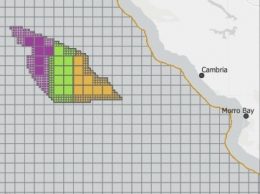Morro Bay plans $100 million makeover to attract more visitors
The coastal city of Morro Bay is charting a new future with hospitality and public-serving projects totaling some $100 million either in negotiations or in the planning pipeline.
“There’s not always development options in Morro Bay, but that makes the ones we have that much more lucrative,” said City Manager Scott Collins.
For a city that is 90 percent built-out and surrounded by agricultural land, major development opportunities are significant. These include the repurposing of a number of properties on the harbor, new restaurants and hotels in the works, and a new wastewater treatment plant that will free up coastal land for other facilities.
Another major opportunity is the repurposing of some 110 acres of prime coastal land currently occupied by the shuttered Morro Bay Power Plant.
When the plant closed in 2014, the city suffered losses of about $6 million to $7 million a year in direct revenue, said Mayor John Headding. Vistra Energy currently owns the old power plant site and is crafting a master plan for it that includes light industrial and visitor center uses.
Another large-scale development in the works is the Market Plaza project, which is currently being negotiated with developers, said Community Development Director Scot Graham.
“I think coastal communities have seen a lot of development activity,” said Graham, who previously served in the San Luis Obispo County cities of Pismo Beach and Grover Beach. “Morro Bay sat on the sidelines, and now we’re starting to see some development activity.”
Estimated at $40 million, the mixed-use project would include construction of a high-end hotel with 100-150 rooms as well as improvements to the Centennial Parkway, which connects the waterfront and downtown areas. It would also update public bathrooms and areas located below the bluff overlooking Embarcadero Street and the waterfront.
The city is looking to sell or lease about 1.76 acres on three lots, the bulk of which lies between Market Avenue and Embarcadero Street. The property outlined for the Market Plaza project is listed for $2.5 million by McCarty Davis Commercial Real Estate.
Along with many cities in California, Morro Bay is facing budget challenges related to state CALPers pensions.
“Economically it’s been, for Morro Bay, a challenge over the years to do what I call ‘diversify the economy,’” from a heavy reliance on tourism dollars, Headding said. “We’ve been a single- source economy for so long.”
The city’s annual budget is about $14.5 million, and transient occupancy tax and sales tax make up the majority of it.
But Morro Bay is sensing winds of change, and Headding is optimistic about its future. TOT revenue has been increasing every year for the past decade, and Morro Bay has been identified as a site for renewable wind energy by the Bureau of Ocean Energy Management.
Joint venture Castle Wind is working with federal and state regulators to build a commercial wind farm with 100 floating windmills 30 miles off the coast of Morro Bay.
While the project is still 5-6 years off from being a reality, its potential is substantial for the city in terms of revenue and high paying jobs, Headding said. He added that the development alone would probably cost around $4 billion.
Business owners looking at lease renewals on waterfront property are also considering the kinds of investments they want to make.
“I’m really bullish on Morro Bay,” said Paul Van Beurden, who owns Dutchman’s Seafood House on Embarcadero Street, the waterfront area’s main drag. “I think we have so much to offer compared with other coastal cities.”
Van Beurden, a Morro Bay resident for 51 years, is aware of the challenge of remaining relevant in a city with a population of just over 10,500 people, located at the base of the iconic Highway 1 drive. But he and his siblings, who own businesses throughout the city, are optimistic when it comes to investing in their properties.
Since remodeling, rebranding and obtaining a liquor license for his restaurant in 2010 on the heels of an economic downturn, Van Beurden said he’s seen a 130 percent increase in profitability. Even though he was in debt at the time and had to take out loans to expand, he said it was “probably the best thing I ever did.”
Although the flow of the economy always produces its own challenges, Van Beurden said he’s already considering ways to update his business when the waterfront land, which is owned by the state in a complex leasing system, is up for re-lease in the next 12-13 years.
“Long-term planning” and having a vision are “huge,” he said, and his goal in mapping out the future of his business is staying relevant.
Business owner Cherise Hansson and her husband Travis Leage are also working on revamping their waterfront property.
The pair own and operate boutique gift shop Under the Sea Gallery on Embarcadero Street, and Hansson said she’s in it for the long term.
“I’ve been doing this for 21 years, and about three years ago when the future was questionable for the property, I took a self-evaluation and said, ‘This is where I’m supposed to be.’ ”
Her three children are fourth-generation locals, and she said she sees investing in Morro Bay as a way to build a future community her children can be a part of.
The pair are planning on tearing down the aged beach shop and building an 8,000-square-foot multi-use site. It will include eight Mediterranean-style hotel rooms on the second floor and two retail storefronts on the ground floor, along with a number of spaces for smaller tenants to have shops and eateries.
A harbor walkway for public use and a children’s playground with a large octopus climbing structure are also on the drawing board. If all goes well, construction should begin in the fall of 2020 and wrap up by March 2021.
“It’s not going to be the run-down beach building,” Hansson said of the project, which the couple is funding with savings and loans. “This is our baby and something we want to be extremely proud of.”
• Contact Annabelle Blair at [email protected].










